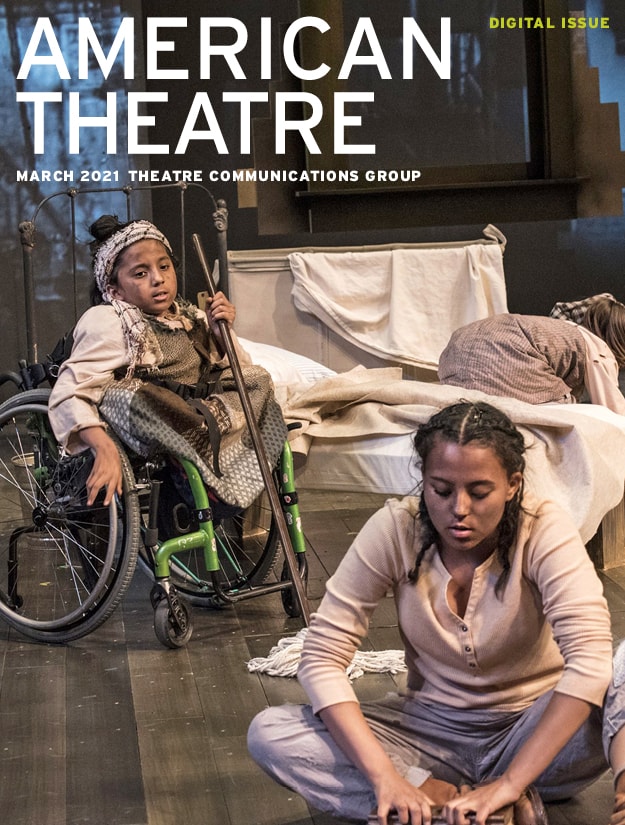Practicing Disability Justice, Honoring Wholeness Onstage
How disabled performing artists are challenging ableism, building access, and imagining new worlds.

Disability is everywhere around us, but most of us who are temporarily non-disabled find it all too easy to ignore, partly through the ableist systems and norms we have inherited, and partly through our own active participation in reinforcing them. This isn’t just unjust to disabled people—it is ignoring a piece of our own humanity, as almost all of us will be temporarily disabled at some point in our lives: in old age, by health events or accidents over which we have no control. Indeed, 26 percent of the U.S. population, or one in every four people, at present have some kind of disability, and by the end of our days all of us will be able to count ourselves among their ranks.
And in few places is the willful ignorance of disability more evident than in the theatre, where the first wheelchair-using disabled performer took the Broadway stage only as recently as 2015, and the number of roles written for disabled actors—let alone the roles made available to them—was then and remains vanishingly small. It was in that year that American Theatre produced its last package of stories about Deaf and disabled theatre workers, which spotlighted the work of companies and artists in creating access and art in the face of institutional indifference, even hostility.
In the years since, the picture hasn’t brightened dramatically, despite some notable highlights: the founding of National Disability Theatre and Spectrum Theatre Ensemble, for instance, or the creation of a new scholarship to support disabled students at Yale School of Drama. But the lens through which the field is viewed has broadened and sharpened to include an intersectional critique of its inequities, both within predominantly white, non-disabled institutions and within disability-focused companies. The concept of disability justice, which infuses and animates some of the stories in the bustling new package on Disability and Theatre we’re proud to publish today (see below), has become widely embraced as a way to name and center the intersecting oppressions of multiply marginalized populations, including the disabled, Black and Indigenous populations, people of color, queer and trans and gender nonconforming folks, immigrants, and the poor. As the theatre field reckons with the demands of We See You, White American Theater and other accountability movements, it is crucial not to lose sight of the intertwined struggles for equity and inclusion waged by and on behalf of the most vulnerable and historically excluded.
One thread that comes through strongly in various pieces of this special package (whose content and tone were set in large part by an extraordinary advisory panel of leaders from the community, in partnership with TCG’s Equity, Diversity, and Inclusion department, and which is authored entirely by disabled journalists and writers) is that disabled theatre workers have for too long shouldered the labor of carving out the terms of their own access and inclusion, either individually or in networks. It has been lonely and punishing work, and it’s long past time for American theatres of all stripes to join that work, to put disabled talent and audiences at the center, not the periphery, of their missions, and to make disability justice and inclusion a core value, from their budget documents to their season brochures.
Another, more hopeful message is also echoed by many voices in this package: that all of us, disabled and non-disabled alike, benefit from greater and more authentic inclusion. Theatremaking is not a zero-sum game; it is simply better, richer, more rewarding when it is by, for, and about all of us.
Rob Weinert-Kendt (he/him), Editor-in-Chief
Creative credits for production photo: Annie was directed by Steve Wilson and Regan Linton, with music direction by David Nehls and Trent Hines, choreography by Debbie Stark and Ronni Gallup, scenic Design by Laura Love and Alex Polzin, costume design by Nikki Harrison, lighting design by Dave Mazzeno, sound design by Craig Breitenbach, video design by Topher Blair, props design by Rob Costigan & Bob Bauer
How disabled performing artists are challenging ableism, building access, and imagining new worlds.
Disability inclusion can’t simply be tacked on as an extra in theatre’s budgets and planning; it must be intentional and funded. The good news is that it benefits everyone.
A roundtable of theatremakers talk about their work, how they make it, and models for inclusive spaces for both artists and audiences.
The theatre field is white-dominated, and disabled and D/deaf companies would seem to be no exception—unless we look deeper and think more intersectionally.
Now 30 years old, the Americans with Disabilities Act has made historic access achievements for audiences. Now how about access for performers and backstage workers?
Here are some folks to have on your radar, from writers to designers, from choreographers to arts administrators.
Meet the field leaders who helped us ideate and create this package of stories.